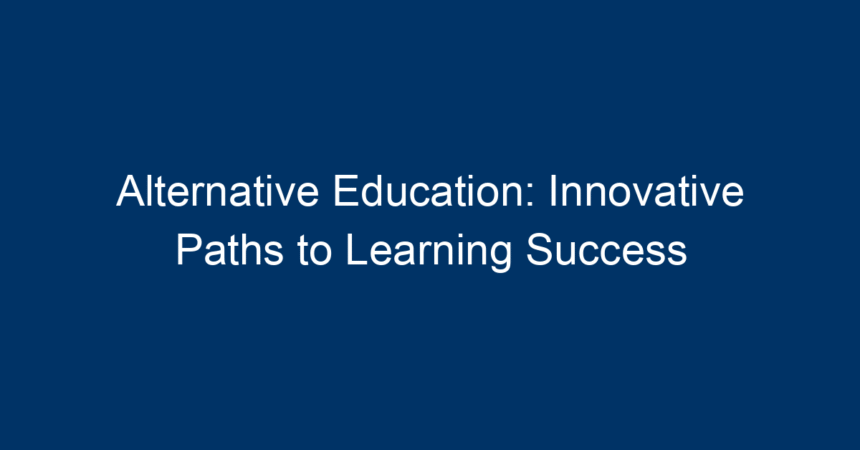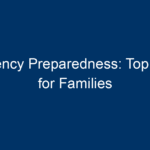In a rapidly changing world, traditional education systems often struggle to meet the diverse needs of learners. Enter alternative education—a transformative approach that diverges from the conventional classroom model. From experiential learning to online platforms, alternative education offers innovative paths to learning success that resonate with today’s students. This article explores the various forms of alternative education, their benefits, and actionable strategies for those interested in implementing these educational frameworks.
Understanding Alternative Education
What is Alternative Education?
Alternative education encompasses a broad range of educational practices that fall outside of mainstream schooling. These methods focus on the unique needs, interests, and circumstances of individual learners. Schools that adopt alternative education philosophies prioritize flexibility and creativity, emphasizing hands-on experiences over rote memorization. This approach is particularly beneficial for students who struggle within traditional settings, such as those with learning disabilities or behavioral challenges.
The Need for Alternative Education
The traditional education system has often been criticized for its one-size-fits-all approach. Many students find themselves disengaged and uninspired in an environment that prioritizes standardized testing over creativity and critical thinking. As societal and job market demands evolve, there is an urgent need for educational frameworks that empower students to become active participants in their learning journeys. Alternative education responds to this need by offering personalized and engaging learning methods.
Various Approaches to Alternative Education
1. Montessori Method
The Montessori Method, developed by Dr. Maria Montessori, emphasizes self-directed learning and hands-on activities. In Montessori classrooms, students are encouraged to explore their interests at their own pace. This approach fosters independence and a love for learning, making it a popular choice for early childhood education.
2. Waldorf Education
Founded by Rudolf Steiner, Waldorf Education focuses on holistic development, blending academics with the arts and practical skills. Curriculum is designed to nurture creativity and critical thinking, with a strong emphasis on experiential learning. This philosophy encourages students to explore their artistic and intellectual potential.
3. Project-Based Learning
Project-Based Learning (PBL) centers around the completion of a project that has real-world relevance. Students work collaboratively to solve problems or create products, allowing them to apply their knowledge in practical situations. PBL not only enhances understanding but also develops critical life skills such as teamwork and communication.
4. Online Learning Platforms
The rise of technology has paved the way for online learning platforms that offer flexible, self-paced courses. From MOOCs (Massive Open Online Courses) to specialized platforms like Khan Academy, these resources provide learners with accessible alternatives to traditional education. Students can explore a wide range of subjects, often for free or at a low cost.
5. Unschooling
Unschooling is a child-led approach to education that advocates for minimal structure and maximum freedom. Families practicing unschooling allow children to pursue their interests without a predefined curriculum. This method is grounded in the belief that learning occurs naturally through life experiences and personal exploration.
Benefits of Alternative Education
1. Personalized Learning Experiences
One of the most significant advantages of alternative education is its ability to cater to individual learning styles. By allowing students to pursue subjects that ignite their interests, alternative education fosters a deeper connection to learning.
2. Enhanced Critical Thinking Skills
Many alternative education models focus on developing critical thinking and problem-solving skills. Through project-based learning and real-world applications, students learn to analyze situations, think creatively, and devise unique solutions.
3. Increased Engagement and Motivation
Students in alternative education settings often exhibit higher levels of engagement and motivation. The interactive and hands-on nature of these programs encourages exploration and curiosity, sending conventional motivation to school to the backburner.
4. Holistic Development
Alternative education often emphasizes the development of the whole child—intellectually, socially, emotionally, and physically. Educational models that incorporate arts, sciences, and practical skills cultivate well-rounded individuals prepared for diverse life paths.
5. Flexibility and Adaptability
Alternative education offers the flexibility necessary to adapt to changing circumstances. Whether it’s the growing prominence of remote work or the unique challenges different learners face, these educational frameworks remain versatile and responsive.
Implementing Alternative Education Strategies
1. Identify Learning Styles
The first step toward implementing alternative education is understanding the learning styles of students. Are they visual learners, auditory learners, or kinesthetic learners? Customizing educational experiences to fit individual learning preferences can significantly enhance the learning process.
2. Foster a Growth Mindset
Encouraging a growth mindset is essential in alternative education. Students should be taught that failure is a part of the learning process and that persistence leads to mastery. By promoting resilience, students can overcome obstacles and embrace challenges.
3. Incorporate Technology
Utilizing digital tools and platforms can effectively integrate alternative education concepts. Virtual reality, online courses, and educational apps can enhance learning experiences, making them more engaging and accessible.
4. Create a Supportive Environment
A supportive learning environment can significantly impact student success. Encourage collaboration and open communication among students, teachers, and parents. This support network fosters an atmosphere where learners feel safe to explore and express themselves.
5. Engage in Continuous Assessment
Traditional grading systems may not align with the principles of alternative education. Instead, focus on continuous assessment methods, such as portfolios and self-reflections. This approach provides a more comprehensive view of a student’s progress and capabilities.
Conclusion: Embracing Alternative Education for the Future
The landscape of education is evolving, and alternative education is at the forefront of this transformation. By embracing innovative learning paths, we can better meet the diverse needs of today’s learners. Alternative education not only addresses the many challenges of traditional schooling but also empowers students to thrive in various aspects of life.
Actionable Insights
- Explore Different Models: Research and consider alternative education models that resonate with your educational goals and values.
- Engage with Communities: Join online forums or local communities that focus on alternative education to share resources and experiences.
- Continuous Learning: Stay updated with the latest trends in alternative education by reading research, attending workshops, or participating in webinars.
- Advocate for Change: Whether you’re a parent, teacher, or student, advocate for more inclusive and flexible educational policies that incorporate alternative approaches.
By understanding and implementing alternative education strategies, we can create a more inclusive, engaging, and effective educational landscape that prepares learners for success in an ever-changing world. The future of learning is here—let’s embrace it!




